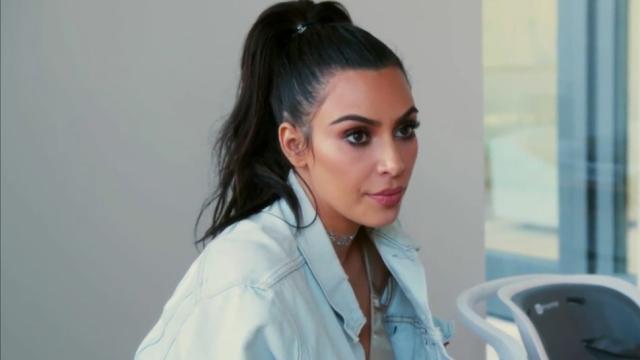On the latest episode of Keeping Up with the Kardashians, doctors told Kim that a third pregnancy would be risky and even life-threatening owing to a potential complication known as a “retained placenta”. Here’s what that means, and why Kim is now seriously considering getting a surrogate mother.
Image: Keeping Up with the Kardashians/E!
During the episode, Kardashian visited two doctors, both of whom advised her to avoid a third pregnancy given the particular complications she experienced during her first two pregnancies.
“You never know if you might have the same type of problem that could be more serious this time,” said Dr Paul Crane. “You’re always taking a little bit of a chance. There are situations where retained placenta could be life or death.” To which Kris Jenner added, “You could bleed to death.” A fertility specialist echoed these sentiments, advising: “Using a surrogate is not an unreasonable option. If our goal is to grow your family like you want to, then a surrogate makes sense.”
As noted by the doctors, a retained placenta is serious business. It’s when all or some of the placenta stays inside a mother’s womb after birth. The placenta is an organ that provides oxygen and nutrients to the fetus, and it removes waste from the baby’s blood. Normally, the placenta, which is attached to the wall of the mother’s uterus, is expelled during the “third stage” of labour, and that usually happens about a half hour after the baby is born. (The next time a mother is pregnant, a new placenta forms.) But in a small number of cases the placenta, or parts of it, gets stuck, leading to some serious complications.
When the placenta or portions of it remain in the womb, the mother can experience symptoms such as heavy bleeding (post-partum hemorrhage, or PPH), stomach cramps, fever and an inability to produce breastmilk. In some cases, the bleeding can be severe enough to threaten the life of the mother. If any fragments of the placenta remain, a mother may have to be readmitted to hospital to have them removed. The surgery is serious enough that the mother is put under anaesthetic, and it needs to happen a few hours after birth to prevent bleeding. Antibiotics are typically prescribed to avoid infection.
Kardashian had preeclampsia during her first pregnancy, which involves high blood pressure, fluid retention and placenta accreta, which is a form of retained placenta. In Kardashian’s case, her placenta grew too deeply into the uterine wall, and it failed to detach after birth. (Placenta accreta also happens when the placenta embeds itself over a previous cesarean section scar. A retained placenta can also happen when a womb stops contracting, or doesn’t contract enough, to separate the placenta from the wall of the womb (a condition called uterine atony). And it some cases, the placenta separates from the wall of the uterus, but it becomes trapped behind a semi-closed cervix (trapped placenta).
There’s virtually nothing that can be done to prevent a retained placenta, and the risk increases with each passing pregnancy. The condition happens in about two per cent of all deliveries, and has a mortality rate of nearly 10 per cent in rural areas; complications tend to happen when active management of the third labour stage is lacking, including home births. A retained placenta, with its associated haemorrhaging, is a leading cause of maternal mortality. In addition to preeclampsia, other risk factors for a retained placenta include having a previous surgery on the uterus, and being over the age of 35. Kim Kardashian, who is now 36, has already given birth to two children, and she had surgery after her first pregnancy, hence the doctor’s warnings.
Placenta accreta can be diagnosed prior to labour through blood and imaging tests, and if detected, can prompt a cesarean section when the time comes. Alternately, and as advised by Kardashian’s doctors, a prospective mother at high risk should avoid pregnancy and consider surrogacy instead. And indeed, Kim seems to be taking this possibility very seriously. “I’ve come to the conclusion in my mind that I can’t carry another one,” Kim told her mother at the end of the episode. “So now I want to explore surrogacy.”
Which sets up some serious drama for the Kardashians, not to mention reality television as well. Who gets to be the surrogate mum of Kim’s third child?
[People, LiveScience, BabyCentre, NCBI]
